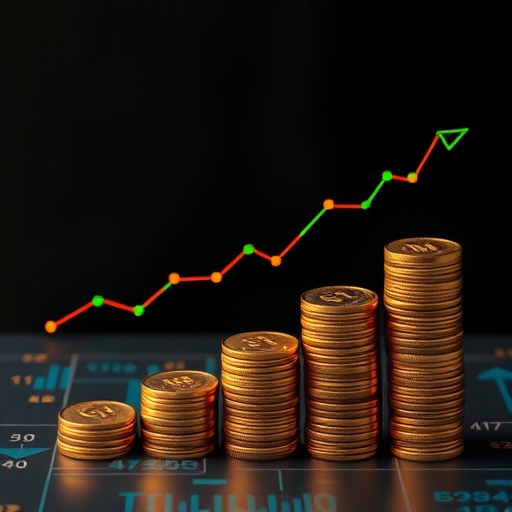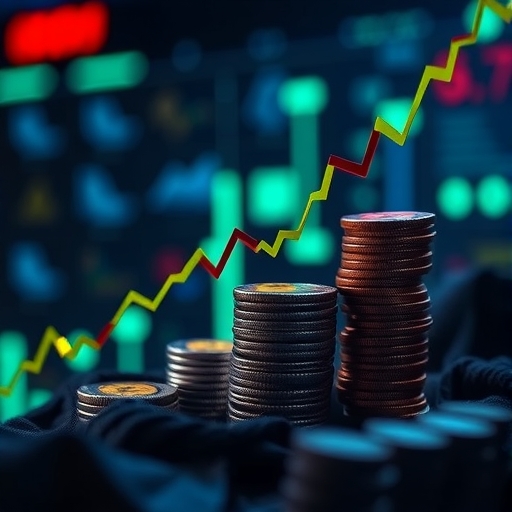Navigating 2025: Top ETFs to Fortify Your Portfolio in an Uncertain Economic Climate
Are you wondering how to strategically position your investments for the dynamic year ahead? The global economic landscape in 2025 presents a complex challenge for investors, marked by decelerating growth, divergent inflation trends, and persistent policy uncertainties. In this multifaceted environment, Exchange-Traded Funds (ETFs) stand out as an exceptionally astute investment vehicle, offering unparalleled diversification, cost-efficiency, and flexibility. This guide delves into the prevailing economic conditions and curates a selection of top ETFs designed to help you strategically position your portfolio for success. We will explore the economic outlook, present our top ETF picks, unpack their investment cases, share best practices for ETF investing, and highlight valuable research resources.

To provide a clearer picture of what lies ahead, this article aims to cover several crucial aspects for informed investment decisions:
- Understanding the key economic forces at play in 2025, including growth projections and inflation trends.
- Identifying specific Exchange-Traded Funds that are well-suited to navigate these economic conditions.
- Providing insights into the strategic advantages of using ETFs for portfolio construction.
Here is a concise overview of the central economic themes expected to influence markets in 2025:
| Economic Theme | Description | Investment Implication |
|---|---|---|
| Decelerating Growth | Global growth slowing to 2.4-2.9%, driven by trade tensions and policy uncertainty. | Focus on resilient sectors and high-quality companies. |
| Divergent Inflation | US inflation accelerating (3-3.5% by Q3 2025), Euro area moderating. | Consider inflation-protected assets and currency-hedged ETFs. |
| Policy Divergence | US Fed maintaining rates longer, ECB continuing easing cycle. | Potential for currency volatility and varied regional performance. |
I. The 2025 Global Economic Compass: Understanding Market Headwinds and Tailwinds
As we look towards 2025, the global economic environment is shaping up to be one of cautious growth and significant policy divergence. Global economic growth is projected to decelerate, potentially slowing to a range of 2.4-2.9%. This moderation is largely driven by increased trade tensions and policy uncertainty, which are identified as significant structural shocks impacting global supply chains and investment decisions. For instance, new U.S. trade policies could reshape manufacturing and distribution worldwide, affecting company earnings and market sentiment.

One of the most critical aspects for investors to monitor is inflation. The U.S. economy is anticipated to experience an acceleration in inflation, potentially reaching 3-3.5% by Q3 2025. This contrasts sharply with moderating inflation trends observed in the Euro area. This desynchronization in economic conditions is reflected in central bank policies. While the U.S. Federal Reserve is expected to maintain current interest rates until at least March 2026, the European Central Bank (ECB) is projected to continue its monetary easing cycle. What does this mean for your money? This divergence in central bank policies between the U.S. and other major economies suggests a period of potential currency volatility, which can impact the returns of international investments. Understanding these macroeconomic currents is crucial for making informed investment decisions and choosing the right ETFs.
The table below highlights the differing economic trajectories and policy responses between the United States and the Euro area, which are critical for international investors:
| Economic Factor | United States (Projected for 2025) | Euro Area (Projected for 2025) |
|---|---|---|
| Economic Growth | Decelerating but resilient. | Moderating growth. |
| Inflation Outlook | Accelerating (3-3.5% by Q3 2025). | Moderating trends. |
| Central Bank Policy | Federal Reserve maintaining current interest rates until at least March 2026. | European Central Bank continuing monetary easing cycle. |
| Currency Volatility | Potential for USD strength against other major currencies due to rate divergence. | Potential for Euro weakness due to easing policy. |
II. Strategic ETF Selection: Our Top Picks for Growth, Innovation, and Stability
In a world of economic shifts, how can you build a resilient portfolio? Exchange-Traded Funds offer a powerful solution, allowing you to gain broad or targeted exposure with ease. We have carefully curated a list of leading ETFs chosen for their potential to thrive in 2025’s market conditions, considering the economic outlook and various investment themes. Here are our top picks, categorized by their primary focus:

- U.S. Broad Market & Tech Exposure:
- Vanguard S&P 500 ETF (VOO): For core U.S. large-cap exposure, tracking the performance of the S&P 500 Index.
- Invesco QQQ Trust (QQQ): Focuses on technology and AI innovation, tracking the Nasdaq-100 Index.
- VanEck Semiconductor ETF (SMH): Provides concentrated exposure to the semiconductor industry, a foundational element for future tech growth.
- International Diversification:
- iShares MSCI Japan ETF (EWJ): For developed market exposure with potential from corporate reforms and currency considerations in Japan.
- iShares Core MSCI Emerging Markets IMI UCITS ETF (EMIM): Offers broad exposure to emerging markets, which may present attractive valuations.
- iShares Core MSCI World UCITS ETF USD (Acc) (IWDA): Provides broad global developed market exposure, spreading your risk across various mature economies.
- Thematic & Sector-Specific Opportunities:
- Global X U.S. Infrastructure Development ETF (PAVE): Capitalizes on U.S. infrastructure spending initiatives.
- L&G Clean Energy UCITS ETF (RENW): Targets renewable energy, a growing sector driven by global sustainability efforts.
- First Trust Cloud Computing UCITS ETF Acc (SKYE): Invests in companies at the forefront of cloud computing technology.
- VanEck Defense UCITS ETF A (DFEN): Focuses on defense spending, influenced by current geopolitical trends.
- Xtrackers MSCI Global SDG 6 Clean Water & Sanitation UCITS ETF 1C (XDG6): Addresses the critical theme of water and sanitation.
- L&G Battery Value-Chain UCITS ETF (BATT): Provides exposure to the burgeoning battery technology sector.
- Income & Stability-Focused ETFs:
- Schwab U.S. Dividend Equity ETF (SCHD): For quality dividend growth, focusing on companies with a history of consistent dividend payments.
- Schwab U.S. TIPS ETF (SCHP): Offers U.S. inflation protection through Treasury Inflation-Protected Securities (TIPS).
- SPDR S&P 500 EUR Hedged UCITS ETF (SPPE): Provides currency-hedged S&P 500 exposure for European investors, mitigating currency fluctuations.
- Australian Market Focus (Examples for specific regions):
- Betashares Crypto Innovators ETF (ASX: CRYP): For companies involved in the crypto economy.
- Betashares Global Robotics and Artificial Intelligence ETF (ASX: RBTZ): Targets robotics and AI innovation globally.
- Betashares Australian Quality ETF (ASX: AQLT): Focuses on high-quality ASX-listed shares.
- Betashares Diversified All Growth ETF (ASX: DHHF): An all-in-one fund for global and Australian equity growth.
- Vanguard MSCI Index International Shares ETF (ASX: VGS): Provides exposure to developed international markets.
III. Deep Dive: Unpacking the Investment Cases for Key ETFs
To truly understand how these ETFs fit into your portfolio, let’s take a closer look at a few examples. Each of these funds offers targeted exposure to critical investment themes, aligning with our economic outlook for 2025.

Vanguard S&P 500 ETF (VOO)
VOO is a foundational ETF for many investors, designed to track the performance of the S&P 500 Index. This index comprises 500 of the largest U.S. publicly traded companies, offering broad exposure to the U.S. equity market. Investing in VOO is like owning a small piece of America’s leading corporations, providing diversification across various sectors like technology, healthcare, financials, and consumer goods. In an environment of potential U.S. inflation acceleration, large, established companies often have the pricing power to pass on costs, making VOO a resilient core holding.
Invesco QQQ Trust (QQQ)
For those looking to capture innovation, QQQ is an excellent choice. It tracks the Nasdaq-100 Index, which consists of the 100 largest non-financial companies listed on the Nasdaq Stock Market. This ETF is heavily weighted towards technology and growth-oriented sectors, including giants like Apple Inc. (AAPL), Microsoft Corp. (MSFT), Amazon.com, Inc. (AMZN), and NVIDIA Corp. (NVDA). With the rapid advancements in Artificial Intelligence (AI) and digital transformation, QQQ offers a direct way to invest in the companies driving these revolutionary changes. Given the ongoing demand for AI innovation, QQQ stands to benefit from continued technological advancements.
VanEck Semiconductor ETF (SMH)
The semiconductor industry is the backbone of modern technology, powering everything from smartphones to AI data centers. SMH tracks the MVIS US Listed Semiconductor 25 Index, providing concentrated exposure to the leading companies in this vital sector, such as Taiwan Semiconductor Manufacturing Co Ltd (TSM), NVIDIA Corp. (NVDA), and ASML Holding NV. As global demand for advanced chips continues to surge, fueled by AI, 5G, and electric vehicles, SMH offers a targeted way to invest in this high-growth area. It’s an essential consideration if you believe in the continued expansion of digital infrastructure.
Schwab U.S. Dividend Equity ETF (SCHD)
In times of economic uncertainty, income-generating investments can provide a valuable cushion. SCHD tracks the Dow Jones U.S. Dividend 100™ Index, focusing on U.S. companies with a consistent track record of paying dividends and strong fundamentals. This ETF selects companies based on financial strength and dividend history, often including names like Coca-Cola Co (KO) and Verizon Communications Inc (VZ). For investors seeking both income and potential capital appreciation from quality companies, SCHD offers a compelling blend of stability and growth, making it a strategic choice for a balanced portfolio.
Schwab U.S. TIPS ETF (SCHP)
With U.S. inflation potentially accelerating, protecting your purchasing power becomes paramount. SCHP invests in Treasury Inflation-Protected Securities (TIPS), which are bonds issued by the U.S. Treasury designed to protect investors from inflation. The principal value of TIPS adjusts with the Consumer Price Index (CPI), meaning your investment grows with inflation. This ETF tracks the Bloomberg US Treasury Inflation Protected Notes (TIPS) Index and is a direct hedge against persistent U.S. inflation, helping to preserve the real value of your savings. It’s a key tool for managing inflation risk in your portfolio.
IV. Mastering ETF Investing: From Selection to Portfolio Management
Beyond specific recommendations, understanding the fundamentals of ETF investing is key to long-term success. ETFs offer numerous advantages that make them a popular choice for investors of all levels.
Advantages of Exchange-Traded Funds (ETFs)
- Diversification: ETFs allow for instant risk spreading across asset classes, sectors, and geographies. Imagine buying a single share that gives you exposure to hundreds or even thousands of companies, effectively reducing the impact of any single stock’s poor performance.
- Cost-Effectiveness: Generally, ETFs have significantly lower expense ratios (the annual fee charged by the fund) compared to actively managed mutual funds. This means more of your money stays invested, potentially leading to greater long-term returns.
- Accessibility & Flexibility: ETFs are traded like regular stocks on exchanges throughout the trading day, offering liquidity and agility. You can buy or sell them at current market prices, unlike mutual funds which are priced only once a day.
- Targeted Exposure: Whether you want to invest in a specific industry like robotics, a particular region like Japan, or a trend like clean energy, there’s likely an ETF for that. This allows for precise strategic investment in themes you believe in.
These advantages make ETFs a versatile tool for various investment strategies. Here’s a summary of the core benefits:
| Benefit | Description |
|---|---|
| Broad Diversification | Gain exposure to numerous assets, sectors, or regions with a single investment, reducing specific risk. |
| Lower Costs | Typically feature lower expense ratios compared to actively managed funds, preserving more of your returns. |
| High Liquidity | Traded throughout the day like stocks, allowing for flexible entry and exit points at market prices. |
| Transparent Holdings | Most ETFs disclose their holdings daily, providing clear insight into what you own. |
Best Practices for ETF Investment
To maximize your chances of success, consider these practical steps when building your ETF portfolio:
- Align ETF Choices with Personal Financial Goals and Risk Tolerance: Before investing, ask yourself: What are your goals (e.g., retirement, down payment)? How much risk are you comfortable with? Your answers should guide your ETF selections.
- Prioritize Diversification and Understand Underlying Indexes/Strategies: Don’t just pick one ETF. Build a diversified portfolio that spreads your investments across different asset classes (stocks, bonds), sectors, and geographies. Always research what index an ETF tracks and how it achieves its investment objective.
- Scrutinize Expense Ratios, Trading Commissions, and Bid-Ask Spreads: Even small fees can erode returns over time. The expense ratio is the annual fee. Trading commissions are fees for buying/selling. The bid-ask spread is the difference between the highest price a buyer is willing to pay and the lowest price a seller is willing to accept; a wider spread means higher trading costs.
- Assess Historical Performance and Tracking Error, but Avoid Chasing Past Returns: While past performance doesn’t guarantee future results, it can give you an idea of how an ETF has behaved. Tracking error measures how closely an ETF’s performance matches its underlying index. However, don’t solely buy an ETF just because it performed well last year; conduct your own due diligence.
- Consider Liquidity (AUM and Trading Volume) and Provider Reputation: Assets Under Management (AUM) indicates the size of the fund. High trading volume means it’s easier to buy and sell without impacting the price. Reputable providers like Vanguard, iShares, and Schwab generally offer well-managed funds.
- Understand the Differences Between Passive and Active ETFs: Most ETFs are passive, meaning they simply track an index. Active ETFs have a fund manager who tries to outperform an index, which often comes with higher fees but potentially higher returns (or losses).
Common ETF Investing Mistakes to Avoid
While ETFs offer many benefits, investors should be mindful of potential pitfalls to ensure their portfolio remains robust.
- Over-Concentration in a Single Area: Putting all your eggs in one basket, even if it’s an ETF, can lead to significant losses if that sector or region underperforms.
- Ignoring Costs: Overlooking expense ratios, trading commissions, or wide bid-ask spreads can quietly eat into your returns over the long term.
- Chasing Past Performance Without Due Diligence: An ETF that performed well last year might not do so again. Always understand the underlying reasons for past performance and evaluate its future potential.
- Failing to Rebalance Portfolios: Your portfolio’s asset allocation can drift over time. Regularly rebalancing ensures your investments remain aligned with your risk tolerance and financial goals.
- Misunderstanding Specific Risks of Specialized or Leveraged ETFs: Some ETFs, like leveraged or inverse ETFs, are designed for sophisticated investors and involve significant risks. Always read the prospectus and understand what you’re investing in.
V. The Evolving ETF Landscape and Essential Research Hubs
The ETF industry is dynamic and continues to grow at an impressive pace. Global ETF assets are projected to reach $14 trillion by the end of 2024 and could potentially hit $18 trillion by 2027. This growth is fueled by increasing investor adoption and innovation within the industry. We are seeing a strong bullish sentiment towards bond ETFs, which are attracting significant flows as investors seek diversification and stable income streams amidst changing interest rate environments. Furthermore, active ETFs are experiencing significant demand and growth, particularly in the U.S., offering investors more choices beyond traditional index-tracking funds.
The expansion of the ETF market reflects its growing importance in global investment portfolios, driven by factors such as:
- Increased accessibility for retail investors through online brokerage platforms.
- Continuous product innovation, offering more granular and thematic investment opportunities.
- A shift towards passive investing strategies due to lower costs and competitive performance.
To stay informed and conduct your own thorough research, a wealth of online resources is available. These platforms offer everything from daily news and in-depth analysis to comparison tools and educational content. Here are some notable platforms and blogs for comprehensive ETF research:
- ETF.com: A leading source for ETF news, data, and analysis.
- Seeking Alpha: Offers a wide range of investment analysis, including many articles on ETFs.
- Morningstar: Provides independent investment research, ratings, and data for ETFs and other investments.
- NASDAQ: Offers market data, news, and insights, including dedicated sections for ETFs.
- ETF Daily News: A platform for daily updates and commentary on the ETF market.
- ETF Trends: Provides insights into ETF industry trends and investment strategies.
- WisdomTree ETF Blog: Offers perspectives from a prominent ETF issuer.
- The Motley Fool: Provides investment advice and analysis, often covering popular ETFs.
- Just One Lap & The Belgian Investor: Examples of regional blogs offering specific market insights.
- Fidelity Investments & Charles Schwab: Major brokerage firms that offer extensive ETF research tools for their clients.
Conclusion
Successfully navigating the investment landscape of 2025 demands a thoughtful and adaptable approach, with Exchange-Traded Funds emerging as an indispensable tool for achieving diversified and resilient portfolios. We’ve explored the economic currents of decelerating growth and diverging inflation, highlighted key ETFs for growth, innovation, and stability, and shared essential practices for effective ETF investing. By prioritizing long-term objectives, understanding inherent risks, and continuously educating yourself through reliable resources, you can leverage the power of ETFs to build and sustain wealth amidst economic uncertainties.
Disclaimer: This article is for informational and educational purposes only and does not constitute financial advice. Investing in Exchange-Traded Funds (ETFs) involves risks, including the potential loss of principal. Always consult with a qualified financial advisor before making any investment decisions. Past performance is not indicative of future results.
Frequently Asked Questions (FAQ)
Q: Why are ETFs considered a suitable investment vehicle for an uncertain economic climate like 2025?
A: ETFs offer unparalleled diversification, cost-efficiency, and flexibility, allowing investors to gain broad or targeted exposure across various asset classes, sectors, and geographies, which helps mitigate risk during periods of economic uncertainty and market volatility.
Q: What are some key economic factors to monitor in 2025 that could impact ETF performance?
A: Key factors include global economic growth deceleration (projected 2.4-2.9%), divergent inflation trends (U.S. inflation accelerating vs. Euro area moderating), and central bank policy divergence (U.S. Fed holding rates longer vs. ECB easing), all of which can influence market sectors and currency movements.
Q: How can investors choose the right ETFs to align with their financial goals?
A: Investors should align ETF choices with their personal financial goals and risk tolerance, prioritize diversification, understand the underlying indexes or strategies of the ETFs, scrutinize expense ratios and trading costs, and assess liquidity and provider reputation. Avoiding common mistakes like over-concentration and chasing past performance is also crucial.



No responses yet